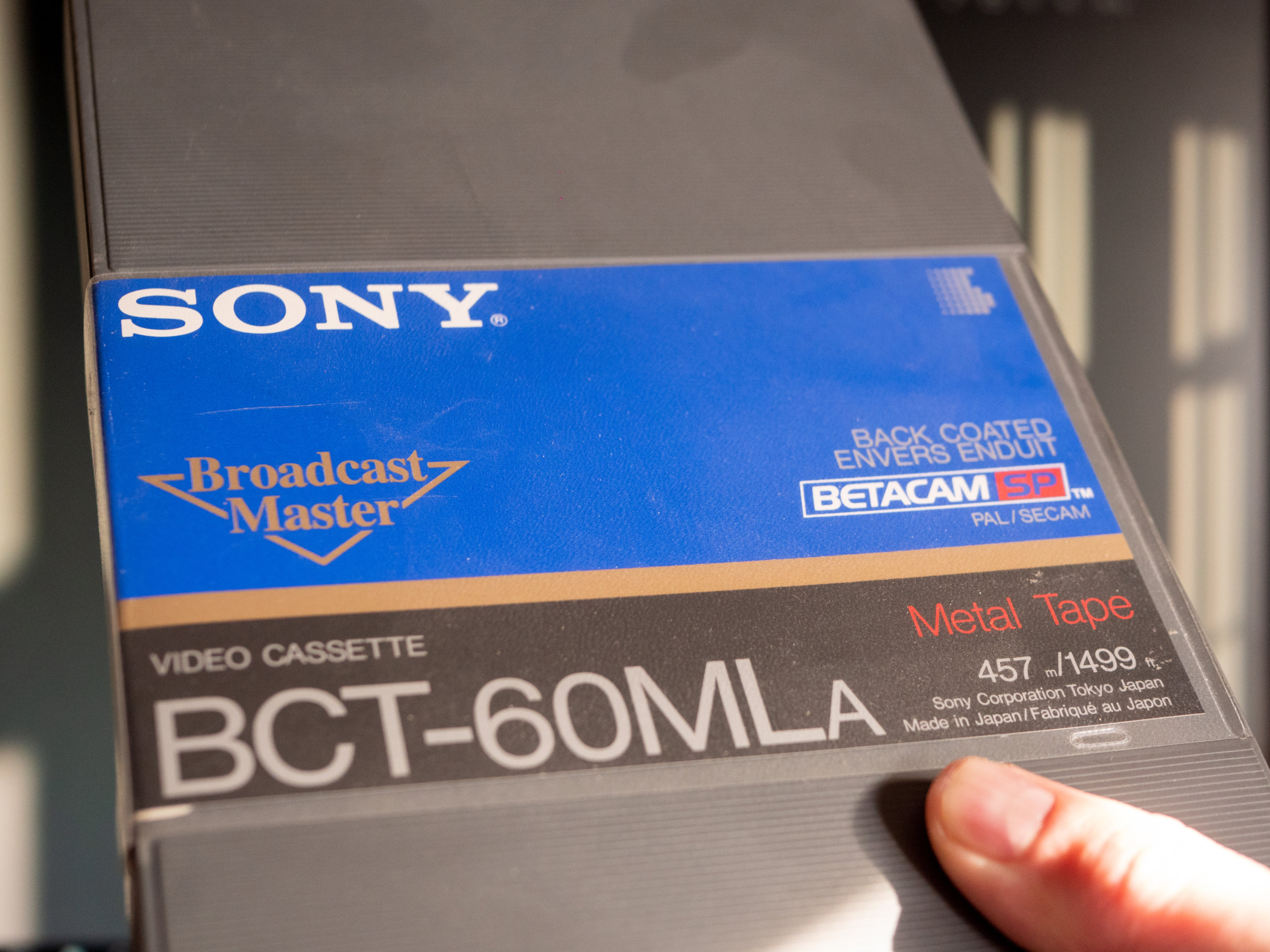With so many video formats developed and released in the last quarter of the 20th century — and the same companies producing multiple products with similar names — it’s easy to confuse one format for another. Betamax and Betacam are great examples. But it’s important to know how to distinguish between them, so you can use, play, store, and digitize them correctly.
In this post, we explain exactly what Betacam is, how it differs from Betamax, and how to watch and preserve your Betacam tapes.
WHAT IS BETACAM?
Betacam is the name of one of Sony’s high-quality videotape technologies. Many products were released under the Betacam name, from the first tapes in 1982 to the digital HDCAM SR in 2003.
When someone says “Betacam,” they could be referring to a few different types of products: Betacam tapes, Betacam camcorders, and Betacam video recorders. The Betacam format was available to both consumers and professionals, but it was much more successful in professional circles. It stayed popular until around 2006 when it was phased out by digital recording products that didn’t require tapes.
A TIMELINE OF BETACAM
As Betacam was around for so long, here’s a timeline showing which products were popular when.
1982 – Betacam is released: The first Sony Betacam products released in 1982 evolved from the Betamax format but were designed to replace the U-matic format which had long been popular for television and other professional uses.
1986 – Betacam SP is released: Four years later in 1986, the company launched Betacam SP (Superior Performance) which increased the resolution from 300 to 340 lines and extended the run time from 30 to 90 minutes.
1994 – Digital Betacam is released: Betacam SP tapes stayed popular for several years until the first Digital Betacam was revealed in 1994. As the name suggests, this product made the transition from analog to digital and used 10-bit DCT compressions and 4:2:2 sampling. There were two cassette types available, one holding 124 minutes of videos and the other holding 40 minutes.
1996 – Betacam SX is released: In 1996, Sony released a cheaper alternative to Digital Betacam called Betacam SX. This was a digital version of Betacam SP designed to work with older SP equipment. The idea was that this would make it easier for TV stations and other customers to transition to digital.
1996 – MPEG IMX is released: This update further developed the Digital Betacam format, encoding at a higher bitrate and using IMX intraframe compression.
1997 – HDCAM is released: In 1997, Sony released the first HD format for Betacam — HDCAM. Footage filmed with an HDCAM could be played back at a resolution of 1920×1080. Sony used it to target the cinema industry.
2003 – HDCAM SR is released: Finally, in 2003, a “Superior Resolution” version of the HDCAM was released. It was commonly used for producing HDTV television. It was popular for a few years before being slowly phased out by tapeless alternatives. However, HDCAM SR tapes are still commonly used for archiving footage.
WHY THE SIZE DIFFERENCE BETWEEN BETACAM AND BETACAM SP?
To increase the resolution and run time of the Betacam format, Sony had to increase the size of the film tape — and consequently the size of the cassette too. That’s why Betacam SP tapes are larger than the original Betacam ones.
Unfortunately, this meant the Superior Performance tapes couldn’t fit in equipment designed to take normal Betacam tapes.
WHAT’S THE DIFFERENCE BETWEEN BETACAM AND BETAMAX?
Betamax is a famous analog video format launched in 1975 by Sony. It was targeted almost exclusively at consumers, while Betacam was aimed at professionals.
People often confuse Betacam and Betamax because the original Betacam cassettes looked almost identical to Betamax ones. Betacam tapes could also be used in a Betamax VCR and a blank Betamax tape could work on a Betacam deck.
This wasn’t an intended feature, however. And, because the tech inside the tapes was so different, Sony discouraged users from mixing formats and products. The main problem was that Betacam products moved the tape inside the cassettes much faster and this could damage Betamax tapes.
CAN BETAMAX PLAY BETACAM?
The short answer is no. However, the original Betacam video tapes did use almost the same cassette as Betamax, and the two could be inserted into either type of camcorder or machine. But even in the few situations where you could force some extent of interchangeability, it’s better not to. Now that the taps are getting old, it’s important not to do anything that risks damaging them.
HOW CAN I WATCH BETACAM TAPES?
Unfortunately, finding original equipment to watch your Betacam tapes on isn’t easy. Even if you do find a broadcast-level Betacam VTR for sale somewhere, it’s likely to cost upwards of $3,000.
The easiest and most affordable way to watch your tapes — and preserve their content — is to transfer them onto a DVD or USB flash drive.
HOW LONG DO BETACAM TAPES LAST?
The first thing to remember is that there are lots of different types of Betacam tapes. You might have original tapes from 1982 or tapes from sometime closer to 2003. No matter how old they are, however, proper storage is the only way to ensure they last as long as possible.
If you don’t know how your tapes have been stored throughout their lifespans or you know it wasn’t optimal, the best way to ensure the footage stays safe is to digitize the content.
HOW TO DIGITIZE BETACAM TAPES
At EverPresent, we can digitize all Betacam tapes, from the originals to BetaSP or DigiBeta. Because of the popularity of Betacam in professional circles, most projects we receive come from institutions with important historical or broadcast footage.
If you have home videos on Betacam, however, we’d love to help you digitize those too! Just get in touch with us here to learn more and discuss your project.



